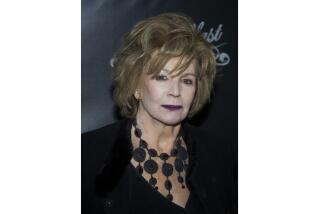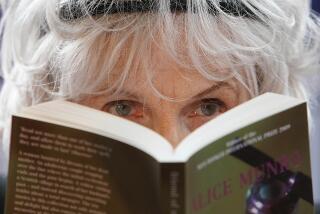‘Flannery: A Life of Flannery O’Connor,’ by Brad Gooch
Flannery
A Life of Flannery O’Connor
Brad Gooch
Little, Brown: 416 pp., $30
Brad Gooch opens “Flannery,” his biography of Flannery O’Connor, with a lost moment: an account of how when O’Connor was 5, the Pathe newsreel company sent a cameraman to her home in Savannah, Ga., to film a chicken she had trained to walk backward. Such an image highlights O’Connor’s lifelong fascination with birds, but most telling is that even at this age, she was elusive, standing just outside our grasp.
“O’Connor’s screen debut,” Gooch writes, “exists in all its fragility in a Pathe film archive. . . . For all of four seconds, O’Connor, a self-possessed little girl, is glimpsed in glaring afternoon light, a wisp of curls peeking from beneath her cap, calmly coping with three chickens fluttering in her face.” Here we have a stunning metaphor for not only her writing but also her existence: brief, glancing, almost impossible to pin down.
“Flannery” is just the second full biography of O’Connor. (The other is Jean W. Cash’s “Flannery O’Connor: A Life.”) It’s not that plenty hasn’t been written about her; she has, Gooch tells us, “become a one-woman academic industry,” subject of countless dissertations and critical studies, as well as one very good group biography, Paul Elie’s “The Life You Save May Be Your Own,” which discusses her through the filter of her Catholicism, along with Thomas Merton, Walker Percy and Dorothy Day.
Yet 45 years after her death at age 39 from lupus, O’Connor resists biographical treatment, since other than her writing, not much happened in her life. An only child, born and raised in Georgia, she left to attend the Iowa Writers’ Workshop in the late 1940s before illness forced her to return home.
For much of her adult life, she lived on a family farm in Milledgeville with her mother, going to church and writing every morning and then receiving visitors and caring for her birds.
“As for biographies,” she once noted, in a line Gooch uses as an epigraph, “there won’t be any biographies of me because, for only one reason, lives spent between the house and the chicken yard do not make exciting copy.” That’s a typically cutting observation -- acute, self-deprecating, laced with irony -- but it also suggests the difficulty for a biographer in coming to terms with O’Connor as a figure independent from her work.
Gooch confronts this problem most directly in the early chapters, which are, by necessity, the least documented -- a portrait of what her childhood might have been. Drawing on interviews and the author’s correspondence, he reveals O’Connor to have been a willful girl, overprotected and precocious, a loner who spoke her mind.
This didn’t change as she got older; indeed, she remained remarkably consistent, eschewing the trappings of adulthood (independence, romance) for the protected bubble of Milledgeville. “When I was twelve I made up my mind absolutely that I would not get any older,” she wrote in 1956 to her friend Betty Hester. “I don’t remember how I meant to stop it. There was something about ‘teen’ attached to anything that was repulsive to me.”
This is an important point, explaining the grotesque innocence of O’Connor’s fiction, the way even her most extreme characters -- “Wise Blood’s” Hazel Motes, for instance -- are touched by childlike inexperience.
Yes, O’Connor was a hothouse flower, but a hothouse flower of a particularly tenacious sort. She used her distance from the world to see allegorically, producing fiction that, in the words of Merton, was reminiscent not so much of “Hemingway, or Katherine Anne Porter, or Sartre, but rather of someone like Sophocles.”
The trouble with Sophocles, though, is that he’s no longer available to us -- he’s just a reference point. The same, oddly, is true of O’Connor, despite the fact that she lived so recently. Gooch’s account of her childhood relies too heavily on her fiction; over and over, he draws parallels between the artist and the art.
“If the little girl of ‘A Temple of the Holy Ghost’ embodied her anti-nun sentiment,” he writes of her confirmation, “she also displayed more vulnerable girlhood devotion.” Later, discussing the death of O’Connor’s father when she was 15, he surmises: “While many have noticed the dominant place of widows in her fiction, every widow, or orphan, implies a missing husband or father.” Certainly the role of the literary biographer is to tease out the roots of the work, but here, it’s not quite enough to go on. Only after O’Connor arrives in Iowa and her writing becomes front and center does “Flannery” truly come to life.
That’s because Gooch is brilliant on the fiction, passionate and smart, able to contextualize both the individual pieces and the scope of the career. He astutely notes that, despite producing two novels, “Wise Blood” and “The Violent Bear It Away,” O’Connor was not really a novelist, which is why those books don’t quite hold up. She was, rather, perhaps the greatest 20th century American practitioner of the short story, a writer with an acute moral vision who understood that faith and salvation do not necessarily go hand in hand.
Perhaps the most vivid expression of this can be found in “A Good Man Is Hard to Find,” the title story of her 1955 collection, which begins in an almost comic vein before descending into dark chaos.
“This seems to me her great creative moment,” wrote her friend, the writer Ashley Brown, and it’s a sentiment Gooch shares. The key, he suggests, was her decision, in the wake of “Wise Blood,” to write about “folks,” not “freaks” -- not out of any sentimental feeling but to get at the ethical complexities of the everyday.
“O’Connor,” Gooch writes, “said that modern writers must often tell ‘perverse’ stories to ‘shock’ a morally blind world. ‘It requires considerable courage,’ she concluded, ‘not to turn away from the story-teller.’ ” Here we have the essential issue, what drove O’Connor all along. A devout Catholic (“I read a lot of theology because it makes my writing bolder,” she once admitted), she was aware that faith has limits, that everything is up for grabs. And yet, as Gooch notes, what else is there? How else do we make sense of who we are? It is this tension that “Flannery” brings into focus, although in the end, O’Connor can’t help but remain as unknowable as the girl in the forgotten newsreel.
Ulin is book editor of The Times.
More to Read
The biggest entertainment stories
Get our big stories about Hollywood, film, television, music, arts, culture and more right in your inbox as soon as they publish.
You may occasionally receive promotional content from the Los Angeles Times.











